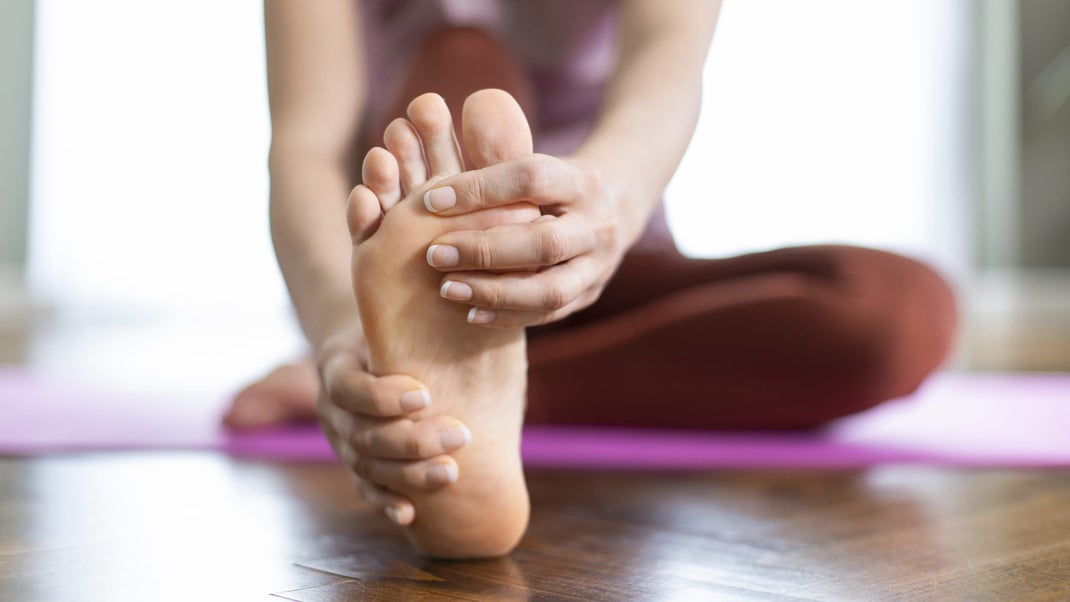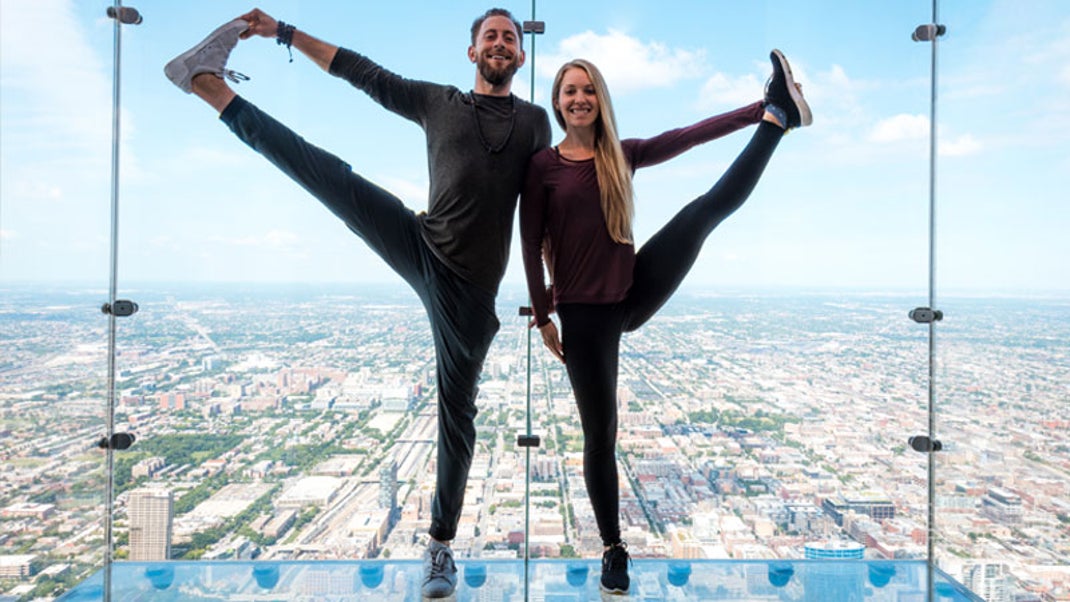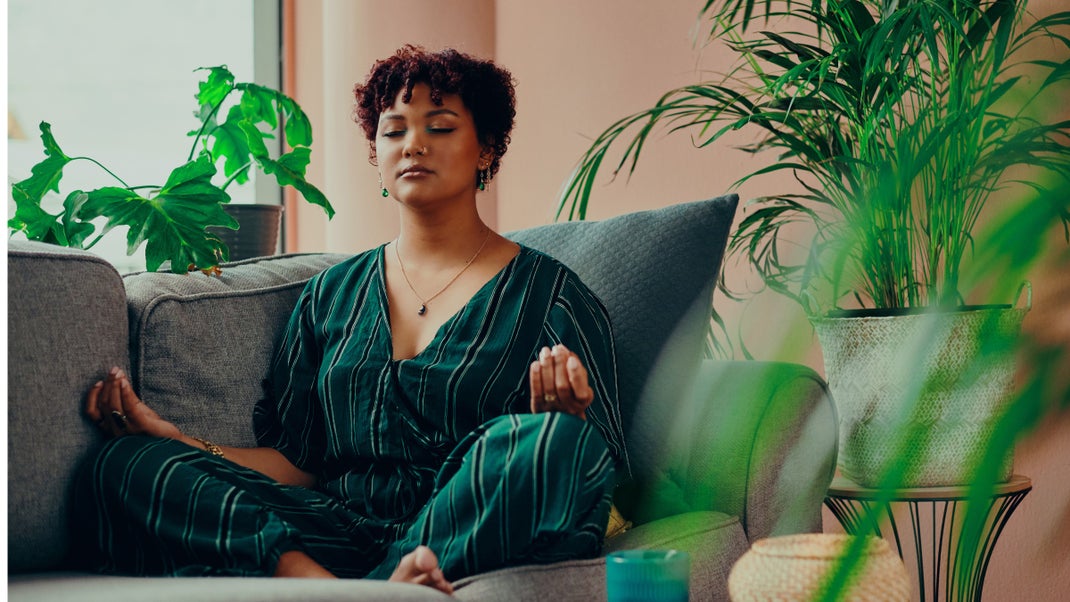Are you looking for an alternative medicine guide? Find the right treatment for you with our comprehensive list of alternatives. Find out what those treatments entail and where to find them. It’s never been easier than this!
Tiffany Caronia lies on her back, fidgets for five seconds, and then slips into Savasana—palms up, legs ever so slightly externally rotated, a gentle smile across her mouth. It’s a pose the 35-year-old vinyasa yoga teacher in Los Angeles knows well, which is why it comes so naturally to her here, on her acupuncturist’s table.
The fact that Caronia is able to quiet her mind and drop any attachment to external senses—the practice of pratyahara, the fifth limb of Patanjali’s eight limbs of yoga—is one of the reasons she experiences such great benefits from her acupuncture sessions, says Caronia’s acupuncturist, Maria Villella, LAC, a vinyasa and Ashtanga Yoga teacher in Los Angeles. “With any healing modality, the more you’re able to put yourself in a deeply relaxed state, the more benefits you’ll receive,” says Villella. “I think it has a lot to do with the mind-body connection we develop on our yoga mats.”
Caronia says her trust in Villella is also key: “I truly believe that what Maria does will help me,” she says. There’s scientific proof Caronia is on to something. Researchers are seeing time and again that our expectations of healing play a big role in the psychological and physical benefits we experience.
In one recent study published in the journal Science Translational Medicine, scientists looked at people with recurring migraine headaches over the course of multiple attacks and found that when docs told patients they had high expectations that treatment would work well, it did—even if it was a sugar pill, and even when the patients were told they were getting the placebo.
Other research has found that when patients believe in the effectiveness of therapy—whether they get a vote of confidence from their practitioners or not—it can stimulate real physiological responses, including changes in heart rate, blood pressure, and even chemical activity in the brain that decreases pain, anxiety, and fatigue.
“This research is proof that there are a number of psychological factors that play a role in how well a treatment works,” says Kristin Skotnes Vikjord, a clinical psychologist and yoga teacher in Amsterdam. “The bottom line is that if you seek out treatment that you believe will work, it has a better chance of working.” Gail Dubinsky, MD, a physician, and yoga teacher in Sebastopol, California, adds that treatments that really resonate with you have another benefit: It’s more likely you’ll stick with them and stay compliant with the other suggestions the practitioner offers.
Of course, there are other important factors to consider when deciding which healing modality will work best for you. For starters, you want to be sure your choice is a safe option for your condition: You might do some research, talk to your doctor, and reach out to others with your same ailment to learn what helped them the most. There’s also the convenience factor: It’s probably not realistic to drive an hour each way for hydrotherapy when there’s massage and reflexology in your neighborhood.
Finally, it’s important to be aware of your changing needs and be willing to shift your treatment course as necessary. Say your back pain gets so much better that you no longer need regular Rolfing sessions and instead are able to stay pain-free with occasional acupuncture. Yoga can help with gaining that awareness.
“Yoga is a process of connecting to the present moment, and by doing that, connecting to the self, which gives yogis access to an inner knowing that helps guide our decisions and prompts us to ask, ‘What do I need right now?’” says Rachel Allyn, Ph.D., a licensed psychologist and yoga instructor in Minneapolis. “It’s important to trust that you’ll know how to answer that question, which can be so beneficial when you’re healing.”
With so many complementary healing modalities available, it can be a puzzle to find the right one. To help you sort through your options, ask yourself which of the following statements resonates most with you right now, and consider the treatment options in that section. Keep in mind there’s a good chance you’ll find many of these therapies beneficial, so use this only as a starting point.
A Guide to Alternative Medicine + Integrative Therapies
If you have to see the research before you believe in the effectiveness of a therapy, consider modalities that are well studied.
Acupuncture
The application of needles along the body’s energy meridians is an ancient Chinese medical intervention that’s been proven to help ease and prevent a host of health woes. In fact, when it comes to alternative therapies that have been studied extensively, acupuncture comes out on top. The benefits range from helping minor conditions (one recent study published in the American Journal of Rhinology & Allergy found that acupuncture relieves sinus problems due to allergies) to more serious issues (researchers at the University of Pittsburgh and Temple University recently found acupuncture eases cancer pain). When it comes to chronic pain, there are hundreds of studies published in well-respected medical journals showing that acupuncture can help treat everything from neck and nerve pain to premenstrual cramps.
Reflexology
This healing modality involves the application of pressure to specific points on the feet, hands, and head that correspond to a different body organ and system. The thinking is that pressing these areas has a beneficial effect on the corresponding organs, as well as overall health. “Reflexology is a zone therapy,” says Robert Thursday, a reflexologist, massage therapist, and editor of Yoga Journal Presents Your Guide to Reflexology.
“Similar to the way anesthesia can numb certain zones of the body, stimulating certain reflexology points can affect very specific organs, nerves, and zones of the body to decrease pain and increase functioning.” For example, if you’re constipated, a reflexologist can work with points that can help heal your digestive tract and get it going again, says Thursday.

Numerous studies funded by the National Cancer Institute and National Institutes of Health show reflexology is effective in reducing pain and treating psychological symptoms, such as anxiety and depression, as well as enhancing relaxation and sleep. One study found that people felt about 4o percent less pain, and was able to stand pain for about 45 percent longer when they used reflexology as a method of pain relief, reports the Journal of Complementary Therapies in Clinical Practice. Another study looking at breast-cancer patients in 13 community-based medical oncology clinics found the health-related quality of life and physical functioning improved in those receiving reflexology, according to research in the journal Oncology Nursing Forum.
Massage therapy
Whether you’re at a spa with dimmed lighting and plush terrycloth robes or in a bare-bones massage therapist’s office, there’s something about the relaxing, healing benefits of a therapeutic massage that almost everyone finds accessible and enjoyable. By pressing, rubbing, and manipulating muscles and soft tissues, massage therapists ease muscle tension and boost circulation, and a growing body of research supports its healing benefits.
Recent research found that multiple 60-minute massages per week were more effective than fewer or shorter sessions for people with chronic neck pain, according to a study published in the Annals of Family Medicine; another compared the short- and long-term effects of structural massage (think therapeutic, deep-tissue treatments), relaxation massage (your general spa variety), and usual care (like meds, ice, and heat) for chronic low-back-pain sufferers.
The results? Both massage groups saw significantly greater improvements in disability and symptoms after 1o week than those who received usual care, reporting they were more active, spent fewer days in bed, and used less anti-inflammatory medication.
Hydrotherapy
This is the external or internal use of water in any form (i.e., ice, steam, or water) with various temperatures, pressures, and durations to treat multiple regions of the body. While it seems new and trendy, it’s actually one of the oldest healing tricks in the book, says Dean E. Neary Jr., ND, chair of the department of physical medicine in the School of Naturopathic Medicine at Bastyr University in Kenmore, Washington.
According to Neary, “Water is an amazingly simple substance that can do all kinds of healing things, proving that some of the best remedies available to us in this high-tech world are some of the most basic.”
From colon-cleansing colonics and salt-water flotation tanks to Spinning and other exercise classes taking place in pools, hydrotherapy treatments run the gamut these days, and there’s plenty of scientific evidence that shows it can improve health in a number of ways. Various hydrotherapy treatments can help cardiovascular and respiratory efficiency, improve stiffness and pain, and even reduce blood glucose levels in those with type 2 diabetes, according to a review published in the North American Journal of Medical Sciences.
IF YOU believe the deepest work happens when you tap into the subtle body, consider therapies focusing on energy work.
Cranial sacral (a.k.a. craniosacral) therapy
How can a practitioner who simply holds the skull and sacrum lightly, using barely detectable movements, create profound health benefits in a patient’s body? Craniosacral therapists believe these minute manipulations boost the circulation of cerebrospinal fluid—the stuff that cushions the spinal cord and brain—improving the functioning of the central nervous system.
While there’s no evidence proving its effectiveness (even the journal Complementary Therapies in Medicine published a review of the available research and “found insufficient evidence to support any therapeutic effect of craniosacral therapy”), proponents find it deeply relaxing and a helpful adjunct to other treatments for pain, trauma, chronic fatigue, and more.
Chakra balancing
Energy work is often all about balance, and chakra balancing focuses on targeting the seven major energy centers—or chakras—in the body in order to prompt healing on both a physical and nonphysical level. “Ancient Vedic (the oldest known Sanskrit literature) knowledge tells us that we have a vital energy called prana moving through the energy channels in the midline of the body, with each chakra, or center of energy, identifying a core human need,” says Candice Covington, a certified aromatherapist, massage therapist, and energy worker at The Chopra Center in Carlsbad, California.
“When a center is open, the energy that flows through allows needs to be met effortlessly; when blocked, energy becomes stagnant and intentions are more difficult to realize.” So if, for example, you have a blockage in your Anahata (heart) chakra, you may have feelings of shyness or loneliness. “Unblocking that energy channel can be a helpful start along your path of looking at repressed emotions and finding ways to break old patterns and overcome obstacles,” says Covington.
Reiki
A Japanese technique based on the principle that a practitioner can channel energy into a client by means of gentle touch or near-touch to activate the innate, natural healing processes of the patient’s body, Reiki is often used for stress reduction and relaxation. “It’s based on the idea that an unseen, universal life-force energy flows through us,” says Andrea Hakanson, LMT, a licensed massage therapist and reiki master in Taunton, Massachusetts, and technical reviewer of the book Yoga Journal Presents Your Guide to Reiki.
“In yoga, we call it prana; the Japanese call it ki. If that energy is low, we’re more likely to get sick and feel stressed; if it’s high, we’re better able to be happy and healthy.” So, the reiki practitioner channels energy to her client to help boost or balance that life force. The result? Relaxation, more energy, and improved health overall say, Hakanson. In fact, many hospitals are starting to incorporate reiki and similar therapies (e.g., “healing touch”) into their offerings to help calm patients and prep them for anxiety-provoking procedures like surgery and chemotherapy.
If you want a hands-on approach, consider bodywork therapies that involve a practitioner using physical manipulation.
Zero balancing
Developed by an osteopath who became an acupuncturist, this modality works on the relationship between a person’s energy system and their physical structure. So, while it is a hands-on treatment—practitioners use finger pressure and gentle traction on areas of tension in the bones, joints, and soft tissue—the areas where you’ll be gently manipulated depend on where your energy is “stuck.”
It’s believed this therapy helps to clear blocks in the body’s energy flow, amplify vitality, and improve postural alignment, says Linda Wobeskya, a licensed physical therapist and co-director of the Zero Balancing Certification Program in Marin County, California. “We balance the areas where your energy meets your physical structure,” she says.
Rolfing Structural Integration
While a Rolfing session can feel like a very deep-tissue massage, there’s actually a lot more going on. Named after its founder, biochemist Ida P. Rolf, Ph.D., this form of bodywork reorganizes the connective tissues—called fascia—that surround, support, and penetrate all of the muscles, bones, nerves, and internal organs. Your practitioner will use his or her fingers to press deeply into your muscles and release tension in the fascia. It’s such deep work that it can feel as if your practitioner’s fingernail is digging into your skin, even though it’s not. As such, there’s a good chance you may not find a Rolfing session as relaxing as massage therapy. However, an intense sensation often passes quickly, and most proponents say the muscular release is well worth any discomfort, helping to restore good posture, energy, and flexibility.
Acupressure
Perhaps you’re interested in acupuncture but hate needles, or maybe you want an even more hands-on manipulation than acupuncture provides. If so, acupressure is a great option, as it targets the same points as acupuncture—minus the needles. To get a similar effect, the practitioner will use his or her fingers, hands, or elbow to apply pressure to specific points of the body in order to help relieve pain and to influence the function of internal organs and body systems. There are a number of studies showing acupressure may be helpful in easing pain, nausea, and anxiety.
If you don’t want to feel like a patient, consider therapies that require you to put in some work and tap into your senses.
Biofeedback
Imagine your doctor connecting a handful of painless electrical sensors to various spots on your body in order to help you receive real-time feedback via a computer screen about what’s happening internally. Then, using this feedback, he or she helps you make subtle changes—say, slowing your breath or visualizing the muscles of your bowel relaxing—to elicit physiological changes that you can see on a monitor, ultimately helping you learn how to use these techniques when you’re at home. This is biofeedback, and it’s proven to help treat a variety of medical conditions, including urinary incontinence, chronic pain, anxiety, high blood pressure, irritable bowel syndrome, and more.
Art & Music Therapy
Using art and music to address physical and emotional needs might sound like just a nice way to spend the afternoon, but there’s a growing body of research showing these artistic interventions can deliver a wide range of benefits. One review of 12 studies, published in the journal Psycho-Oncology, found that giving cancer patients an opportunity to express themselves via art helped them manage treatment-related symptoms. Music therapy—everything from playing soothing tunes in the neonatal intensive care unit to applying low-frequency sound (a.k.a. vibration) directly to the body of Parkinson’s patients—can improve outcomes and symptoms.
Aromatherapy
Essential oils extracted from plants have been used therapeutically for thousands of years to improve physical, emotional, and spiritual well-being. While experts aren’t entirely clear how it works, many believe our sense of smell communicates with parts of the brain that store emotions and memories, which influence health, says Covington.
“For example, there’s some evidence to show lavender stimulates the activity of brain cells similar to the way some sedative medications work,” she says. What’s involved in a session? Your aromatherapist will apply essential oils topically, or ask you to breathe them in via a piece of cloth, steam machine, vaporizer, or spray. “Aromatherapy can be used in a range of settings—from hospitals and integrative treatment rooms to your own home,” says Covington, and it’s been shown to help ease pain, depression, and more.
No matter which complementary therapy you choose, try to keep an open mind, and remember Allyn’s advice to continually check in with yourself: “As yogis, we have a unique ability to trust ourselves, which puts us in a good position to be able to receive the benefits of many of these healing modalities,” she says.
Get the Most From Your Alternative Medicine Treatment
No matter which healing modality you choose, there are a few tips to keep in mind to make the most of your treatment and experience the best results, says Gail Dubinsky, MD, a physician, and yoga teacher in Sebastopol, California:
- Find a primary care practitioner who’ll keep tabs on your care. This is especially important if you have a chronic or complicated problem, says Dr. Dubinsky. “That primary care practitioner is going to be able to help you assess what’s working and what’s not, and make adjustments as necessary,” she says. “If you don’t have this, it’s like having too many cooks in the kitchen with no chef.”
- Avoid doing too many therapies at once. If you’re getting four or five treatments every week, how can you tell what’s helping? Answer: You probably can’t. “When patients do this, I also worry that they’re not giving their bodies enough time to really absorb what’s going on,” says Dubinsky.
- Support your treatment with lifestyle changes. Even if you feel you’ve landed on the best-matched therapy for you, supplementing your treatment by looking at your diet, exercise routine, and how you handle stress is crucial for lasting benefits, says Dubinsky.
- Check-in with yourself on a regular basis. It’s important to ask yourself whether or not you think your treatments are helping your ailment. If the answer is “No,” it’s OK to scale back or stop going.
Conclusion:
Alternative Medicine Guide: Find the Right Treatment for you no matter which complementary therapy you choose, try to keep an open mind, and remember Allyn’s advice to continually check in with yourself: “As yogis, we have a unique ability to trust ourselves, which puts us in a good position to be able to receive the benefits of many of these healing modalities.”




